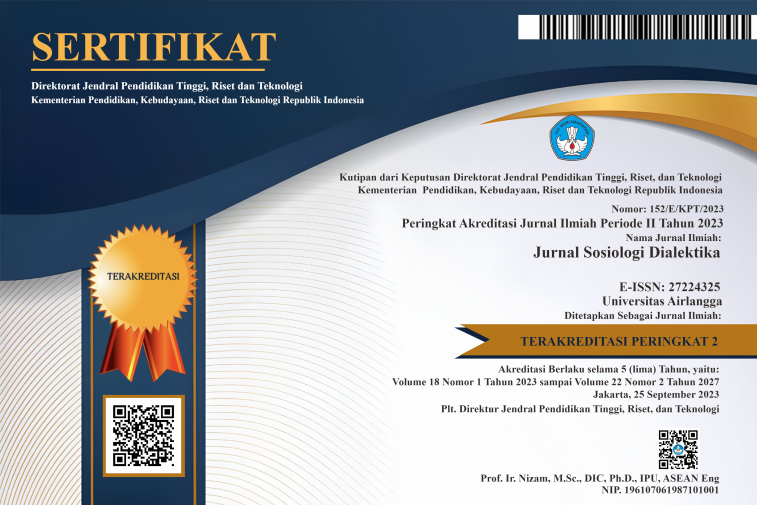Male victims of domestic violence among professional families: Shackled in masculinity
Downloads
Various acts of domestic violence are the reality that troubles family life in various social classes. This study seeks to investigate violence experienced by men among professional families and the causes of women to commit such act. This study deployed qualitative methods and conducted in-depth interviews of 53 informants. The finding of the study indicates that men not only experience single violence, but a variation of violence that occurred in professional families, such as physical, economic, verbal/psychological, and sexual violence. This study shows the triggers for women to commit violence against men among professional families are insecurity, jealousy, and inequality in socioeconomic status. Men are burdened with patriarchy and tend to be passive in reacting to the violence they experience. Masculinity makes male victims of violence suffer triple oppression: They become the victims; they are embarrassed because they get a negative stigma from the community for failing and not being able to lead their families; and when men become the victims, they ‘get punished' because it is considered as ‘abnormal' for men to become victims of violence. Men react to the violence committed by their wives by carrying out latent resistance, manifest resistance, and alienation.
Abdullah I (2006) Sangkan paran gender. Pusat Penelitian Kependudukan (PPK) Universitas Gadjah Mada Yogyakarta.
Allen KR (2016) Feminist theory in family studies: History, reflection, and critique. Journal of Family Theory & Review 8 (2):207-224. https://doi.org/10.1111/jftr.12133.
Allen-Collinson J (2009) A marked man: A case of female-perpetrated intimate partner abuse. International Journal of Men's Health 8 (1):22-40. http://dx.doi.org/10.3149/jmh.0801.22.
Babcock JC, Canady BE, Senior A, & Eckhardt CI (2005) Applying the transtheoretical model to female and male perpetrators of intimate partner violence: Gender differences in stages and processes of change. Violence and Victims 20 (2):235-250. https://doi.org/10.1891/vivi.2005.20.2.235.
Babcock JC, Snead AL, Bennett VE, & Armenti NA (2018) Distinguishing subtypes of mutual violence in the context of self-defense: Classifying types of partner violent couples using a modified conflict tactics scale. Journal of Family Violence 34 (7):687-696. https://doi.org/10.1007/s10896-018-0012-2.
Bahati C, Izabayo J, Munezero P, Niyonsenga J, & Mutesa L (2022) Trends and correlates of intimate partner violence (IPV) victimization in Rwanda: Results from the 2015 and 2020 Rwanda Demographic Health Survey (RDHS 2015 and 2020). BMC Women's Health 22 (1). https://doi.org/10.1186/s12905-022-01951-3.
Barreto M & Ellemers N (2005) The burden of benevolent sexism: how it contributes to the maintenance of gender inequalities. European Journal of Social Psychology 35 (5):633-642. https://doi.org/10.1002/ejsp.270.
Bates EA (2020) "No one would ever believe me”: An exploration of the impact of intimate partner violence victimization on men. Psychology of Men & Masculinities 21 (4):497-507. https://doi.org/10.1037/men0000206.
Boxall H, Dowling C, & Morgan A (2020) Female perpetrated domestic violence: Prevalence of self-defensive and retaliatory violence. Trends and Issues in Crime and Criminal Justice 584 (1):17. https://search.informit.org/doi/10.3316/informit.950678530915547.
Caetano R, Chafer J, Clark CL, Cunradi CB, & Raspberry K (2000) Intimate partner violence, acculturation, and alcohol consumption among Hispanic couples in the United States. Journal of Interpersonal Violence 15 (1):30-45. https://doi.org/10.1177%2F088626000015001003.
Caman S, Howner K, Kristiansson M, & Sturup J (2016) Differentiating male and female intimate partner homicide perpetrators: A study of social, criminological and clinical factors. International Journal of Forensic Mental Health 15 (1):26-34. https://doi.org/10.1080/14999013.2015.1134723.
Carlyle KE, Scarduzio JA, & Slater MD (2014) Media portrayals of female perpetrators of intimate partner violence. Journal of Interpersonal Violence 29 (13):2394-2417. https://doi.org/10.1177%2F0886260513520231.
Chase KA, O'Farrell TJ, Murphy CM, Fals-Stewart W, & Murphy M (2003) Factors associated with partner violence among female alcoholic patients and their male partners. Journal of Studies on Alcohol 64 (1):137-149. https://doi.org/10.15288/jsa.2003.64.137.
Cho H & Wilke DJ (2010) Gender differences in the nature of the intimate partner violence and effects of perpetrator arrest on revictimization. Journal of Family Violence 25 (4):393-400. https://doi.org/10.1007/s10896-009-9300-1.
Cook PW (2009) Abused Men: The Hidden Side of Domestic Violence. California: ABC-CLIO.
Davies M, Pollard P, & Archer J (2006) Effects of perpetrator gender and victim sexuality on blame toward male victims of sexual assault. The Journal of Social Psychology 146 (3):275-291. https://doi.org/10.3200/SOCP.146.3.275-291.
Dowd L (2001) Female perpetrators of partner aggression. Journal of Aggression, Maltreatment & Trauma 5 (2):73-104. https://doi.org/10.1300/J146v05n02_06.
Dutton DG & White KR (2013) Male victims of domestic violence. New Male Studies: An International Journal 2 (1):5-17.
Engel B (2023) The Emotionally Abusive Relationship. Hoboken: John Wiley & Sons.
Foucault M (1975) Discipline & Punish. The Birth of the Prison. New York: Pantheon Books.
Geertz H (1983) Keluarga Jawa. Jakarta: Grafiti Pers.
Gelles RJ (2007) The politics of research: The use, abuse, and misuse of social science data”the cases of intimate partner violence. Family Court Review 45 (1):42-51.
Goldenson J, Spidel A, Greaves C, & Dutton D (2009) Female perpetrators of intimate partner violence: Within-group heterogeneity, related psychopathology, and a review of current treatment with recommendations for the future. Journal of Aggression, Maltreatment & Trauma 18 (7):752-769. https://doi.org/10.1080/10926770903231791.
Goodmark L (2018) Decriminalizing Domestic Violence: A Balanced Policy Approach to Intimate Partner Violence. California: University of California Press.
Hassouneh D & Glass N (2008) The influence of gender role stereotyping on women's experiences of female same-sex intimate partner violence. Violence against Women 14 (3):310-325. https://doi.org/10.1177%2F1077801207313734.
Headey B, Scott D, & De Vaus D (1999) Domestic violence in Australia: Are men and women equally violent. Australian Social Monitor 2 (3):57-62. https://search.informit.org/doi/10.3316/informit.759479315231736.
Hiltz E (2018) The notorious woman: Tracing the production of alleged female killers through discourse, image, and speculation. Theses, Carleton University, Ottawa.
Hine B, Bates EA, & Wallace S (2022) "I have guys call me and say ‘I can't be the victim of domestic abuse'”: Exploring the experiences of telephone support providers for male victims of domestic violence and abuse. Journal of Interpersonal Violence 37 (7-8). https://doi.org/10.1177/0886260520944551.
Hines DA & Douglas EM (2009) Women's use of intimate partner violence against men: Prevalence, implications, and consequences. Journal of Aggression, Maltreatment & Trauma 18 (6):572-586. https://doi.org/10.1080/10926770903103099.
Ho T (2003) The influence of suspect gender in domestic violence arrests. American Journal of Criminal Justice 27 (2):183-195. https://doi.org/10.1007/BF02885693.
Hogan K (2016) Men's experiences of female-perpetrated intimate partner violence: A qualitative exploration. Theses, University of the West of England, Bristol.
Hudson VM, Caprioli M, Bowen DL, & McDermott R (2023) Sex and World Peace. New York: Columbia University Press.
Ismail DE & Sarson MT (2021) Criminology analysis of women's as perpetrators of domestic violence crimes. Jambura Law Review 3: 57-76. https://doi.org/10.33756/jlr.v3i0.10984.
Johnson MP & Ferraro KJ (2000) Research on domestic violence in the 1990s: Making distinctions. Journal of Marriage and Family 62 (4):948-963. https://doi.org/10.1111/j.1741-3737.2000.00948.x.
Johnson N (1995) Domestic violence: An overview. Family violence and the caring professions 101-126. https://doi.org/10.1007/978-1-349-13306-2_5.
Kelly JB & Johnson MP (2008) Differentiation among types of intimate partner violence: Research Update and implications for interventions. Family Court Review 46 (3):476-499. https://doi.org/10.1111/j.1744-1617.2008.00215.x.
Kernsmith P (2005) Exerting power or striking back: A gendered comparison of motivations for domestic violence perpetration. Violence and Victims 20 (2):173-185. https://doi.org/10.1891/vivi.2005.20.2.173.
Kravvariti V & Browne K (2023) Police recognition of gender issues in relation to intimate partner domestic violence and abuse in Greece. Policing: A Journal of Policy and Practice 17. https://doi.org/10.1093/police/paad005.
Lasky NV (2019) Self-Defense and Women Who Kill. The encyclopedia of women and crime. Hoboken: John Wiley & Sons Inc.
Lee A & Lincoln R (2017) Reciprocity and exchange: Perspectives of male victims of family violence. In: The Psychology of Criminal and Antisocial Behavior. Cambridge, Massachusetts: Academic Press. 233-256. https://doi.org/10.1016/b978-0-12-809287-3.00007-9.
Lewis SF, Travea L, & Fremouw WJ (2002) Characteristics of female perpetrators and victims of dating violence. Violence and Victims 17 (5):593-606. https://doi.org/10.1891/vivi.17.5.593.33711.
Lien MI, Lorentzen J, Lien MI, & Lorentzen J (2019) The need to develop the established theory of partner violence further. In: Men's Experiences of Violence in Intimate Relationships. Palgrave Studies in Victims and Victimology. London: Palgrave Macmillan, Cham. 157-171. https://doi.org/10.1007/978-3-030-03994-3_8.
Machado A, Santos A, Graham-Kevan N, & Matos M (2016) Exploring help seeking experiences of male victims of female perpetrators of IPV. Journal of Family Violence 32 (5):513-523. https://doi.org/10.1007/s10896-016-9853-8.
McKeown A (2014) Attachment, personality and female perpetrators of intimate partner violence. The Journal of Forensic Psychiatry & Psychology 25 (5):556-573. https://doi.org/10.1080/14789949.2014.943792.
Reckdenwald A & Parker KF (2008) The influence of gender inequality and marginalization on types of female offending. Homicide Studies 12 (2):208-226. https://doi.org/10.1177%2F10 88767908314270.
Rhatigan DL, Stewart C, & Moore TM (2011) Effects of gender and confrontation on attributions of female-perpetrated intimate partner violence. Sex Roles 64 (11-12):875-887. https://doi.org/10.1007/s11199-011-9951-2.
Rivara F, Adhia A, Lyons V, Massey A, Mills B, Morgan E, Simckes M, & Rowhani-Rahbar A (2019) The effects of violence on health. Health Affairs 38 (10):1622-1629. https://doi.org/10.1377/hlthaff.2019.00480.
Sarmiento YA (2019) Family violence. International Journal of Health & Medical Sciences. https://doi.org/10.31295/ijhms.v2n1.81.
Scarduzio JA, Carlyle KE, Harris KL, & Savage MW (2016) Maybe she was provoked. Violence against Women 23 (1):89-113. https://doi.org/10.1177%2F1077801216636240.
Schroffel A (2004) Characteristics of female perpetrators of domestic violence in group therapy. Smith College Studies in Social Work 74 (3):505-524. https://doi.org/10.1080/00377310409517732.
Seelau SM & Seelau EP (2005) Gender-role stereotypes and perceptions of heterosexual, gay and lesbian domestic violence. Journal of Family Violence 20 (6):363-371. https://doi.org/10.1007/s10896-005-7798-4.
Soselisa FA, Toule ER, & Tuhumury C (2022) Perempuan sebagai pelaku kekerasan dalam rumah tangga. TATOHI: Jurnal Ilmu Hukum 1 (12):1252-1262. https://doi.org/10.47268/tatohi.v1i12.880.
Stets JE & Straus MA (2017) Gender differences in reporting marital violence and its medical and psychological consequences. In: Straus MA, Gelles RJ, & Smith C (ed). Physical Violence in American Families. Oxford: Routledge. 151-166.
Stewart LA, Gabora N, Allegri N, & Slavin-Stewart MC (2014) Profile of female perpetrators of intimate partner violence in an offender population: Implications for treatment. Partner Abuse 5 (2):168-188. https://doi.org/10.1891/1946-6560.5.2.168.
Straus MA (2011) Gender symmetry and mutuality in perpetration of clinical-level partner violence: Empirical evidence and implications for prevention and treatment. Aggression and Violent Behavior 16 (4):279-288. https://doi.org/10.1016/j.avb.2011.04.010.
Stuart GL, Meehan JC, Moore TM, Morean M, Hellmuth J, & Follansbee K (2006) Examining a conceptual framework of intimate partner violence in men and women arrested for domestic violence. Journal of Studies on Alcohol 67 (1):102-112. https://doi.org/10.15288/jsa.2006.67.102.
Swan SC & Snow DL (2002) A typology of women's use of violence in intimate relationships. Violence against women 8 (3):286-319. https://doi.org/10.1177%2F107780120200800302.
Taylor JC, Bates EA, Colosi A, & Creer AJ (2021) Barriers to men's help seeking for intimate partner violence. Journal of Interpersonal Violence 37 (19-20). https://doi.org/10.1177/08862605211035870.
Taylor S, Calkins CA, Xia Y, & Dalla RL (2021) Adolescent perceptions of dating violence: A qualitative study. Journal of Interpersonal Violence 36 (1-2):448-468. https://doi.org/10.1177/0886260517726969.
Thureau S, Blanc-Louvry I, Thureau S, Gricourt C, & Proust B (2015) Conjugal violence: A comparison of violence against men by women and women by men. Journal of Forensic and Legal Medicine 31: 42-46. https://doi.org/10.1016/j.jflm.2014.12.014.
True J (2021) Violence Against Women: What Everyone Needs to Know. Oxford: University Press.
Turan R & Duy B (2020) Self-esteem, attachment, gender roles and social approval as predictors of the attitudes toward dating violence. Turkish Psychological Counseling and Guidance Journal 10 (56):1-36.
Walker LE, Temares AE, Diaz BN, & Gaviria G (2022) Psychological evaluation of battered women who kill in self-defense: A review of 34 cases. Journal of Aggression, Maltreatment & Trauma 32 (1-2):1-19. https://doi.org/10.1080/10926771.2022.2068390.
Weizmann-Henelius G (2006) Violent female perpetrators in Finland. Nordic Psychology 58 (4):280-297. https://doi.org/10.1027/1901-2276.58.4.280.
Whitaker MP (2013) Motivational attributions about intimate partner violence among male and female perpetrators. Journal of Interpersonal Violence 29 (3):517-535. https://doi.org/10.1177%2F0886260513505211.
Yourstone J, Lindholm T, & Kristiansson M (2008) Women who kill: A comparison of the psychosocial background of female and male perpetrators. International Journal of Law and Psychiatry 31 (4):374-383. https://doi.org/10.1016/j.ijlp.2008.06.005.
Zacarias AE, Macassa G, Soares JJ, Svanström L, & Antai D (2012) Symptoms of depression, anxiety, and somatization in female victims and perpetrators of intimate partner violence in Maputo City, Mozambique. International Journal of Women's Health 4: 491. https://dx.doi.org/10.2147%2FIJWH.S29427.

This work is licensed under a Creative Commons Attribution-NonCommercial-ShareAlike 4.0 International License.
1. Copyright of this journal is possession of Editorial Board and Journal Manager, by the knowledge of author, whilst the moral right of the publication belongs to the author.
2. Legal formal aspect of journal publication accessibility refers to Creative Commons Attribution-NonCommercial-ShareAlike (CC BY-NC-SA), implies that publication can be used for non-commercial purposes in its original form (cannot be modified).
3. Every publications (printed/electronic) are open access for educational purposes, research, and library. Other that the aims mentioned above, editorial board is not responsible for copyright violation.















